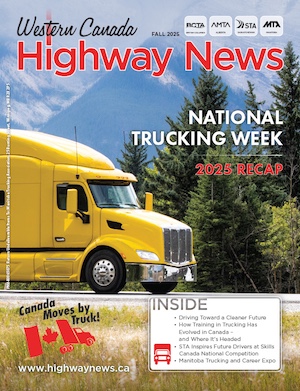By the British Columbia Trucking Association
Of all the challenges facing the trucking industry today, climate change is one that will impact our sector for decades to come.
The electrification of commercial trucking is continuing to make exciting progress, with new product launches and announcements happening on a regular basis.
Electric heavy-duty vehicles will be making their way to a road near you – just not any time soon. Delays in testing and development, largely due to the pandemic, mean there will be limited production in the coming years. As our sector continues to experience barriers to adoption of these vehicles (including limited range, high initial costs, lack of charging infrastructure, and electrical loads on distribution substations), lower emission alternatives must be implemented.
The reliance on the trucking industry is only slated to grow as populations increase and demand for goods rise. With British Columbia experiencing a population growth of 15% over the last decade, approximately 1,000 heavy-duty trucks need to be added to our roads each year to meet this increased demand.1 This is the equivalent of adding 7,000 tonnes of carbon dioxide (CO2) to our atmosphere annually. While there are currently limited zero-emission options for heavy-duty vehicles, training companies and their drivers on fuel efficiency management using the technology that is available today is key to realizing 2030 climate goals for the transportation industry.
Being a world-leader in generating clean, renewable energy, it is only natural for BC to develop ambitious measures to reducing climate pollution. The province has committed to reaching net-zero greenhouse gas (GHG) emissions by 2050 and through CleanBC is working with a range of partners to create opportunities and manage risks from the changing climate. For three consecutive years, the Ministry of Transportation and Infrastructure has partnered with the BC Trucking Association (BCTA) to deliver the CleanBC Heavy-duty Vehicle Efficiency (HDVE) Program. By providing generous incentives towards the purchase and installation of fuel-saving technology, the program aims to lower GHG emissions from the commercial transportation industry and help commercial drivers improve fuel efficiency. Over the past two years, the cumulative impact of the program is estimated to have removed over 4,500 passenger vehicles provincially (20.5 ktCO2e emissions) and 8,800 passenger vehicles across North America (41.5 ktCO2e emissions).2
Running on Less
Educating our industry on low emission and fuel saving technology continues to be a key component of BCTA’s environmental stewardship initiatives, which is why completion of the HDVE Program’s fuel efficiency management course is an important requirement to meet eligibility for incentives.
In the first two years alone, BCTA has educated over 215 companies based in our province, representing almost 22,500 heavy-duty vehicles, with the benefits of using different fuel-saving technologies and practices. The course also instructs how to develop a fuel management program for any size fleet, incorporating measures to improve fuel economy.
Until zero-emission heavy-duty trucks are readily available, reducing fuel consumption is the most effective way to lower emissions from the road transportation industry. Every litre of diesel fuel burned produces 2.7 kilograms of CO2e – the principal greenhouse gas contributing to climate change.3 If we want to reduce GHG emissions, we simply need to burn less fuel.
However, it is important to note that not only is improving fuel efficiency good for the environment, but it also has a positive impact on a company’s bottom line. Fuel is the largest operating expense for BC-based carriers, making up to 29% of operating costs on average (and even up to 51% for come carriers).4 Improving fuel efficiency by just 5% through the utilization of fuel-saving devices can improve a company’s profit margin by 27%.
Cut Emissions, Cut Costs
Several factors can have an impact on fuel consumption, including the vehicle’s transmission, tire selection and maintenance, and aerodynamics of the tractor and trailer. The impact of each factor can be managed to some extent by the driver (e.g., smoother braking and acceleration or altering speed to reduce the drag on the vehicle), however there are several types of technology available on the market that can reduce fuel consumption effectively:
• Wide-based tires are a practical tool to reducing rolling resistance and have been found to offer fuel savings of approximately 3-6% per vehicle each year, or $2,100-$4,200.5
• Automatic transmissions are more fuel efficient than their manual counterparts and can provide annual fuel savings of around 4.5%, or $3,150.5
• Aerodynamic devices such as cab deflectors, wheel fairings, side skirts, and boat tails reduce drag on a heavy-duty vehicle providing 3% in fuel savings each year, or $2,100.5
Anti-idling devices are also extremely effective tools in reducing fuel consumption. The average North American long-haul truck idles for an average of 1,800 hours per year and consumes an estimated four litres of fuel per hour while idling.6 This costs over $9,000 in fuel and produces 18,720 kilograms of CO2 per truck each year.7 Eliminating unnecessary idle time can be as simple as installing auxiliary power units (APUs), automatic engine start/stop systems, or stand-alone cab air conditioning units or heaters. A diesel APU has a fuel cost of approximately $936 per year, providing up to $8,400 of fuel cost savings annually.
One of the largest fuel savings comes from alternative fuel options:
• Liquefied natural gas (LNG) and compressed natural gas (CNG) can provide savings of 40-60%, or approximately $28,000 each year. Natural gas fuel can reduce GHG emissions from heavy-duty trucks by up to 30%, or if renewable natural gas is being used, up to 90% when compared to diesel or gasoline.7
• Hydrogen co-combustion systems can retrofit any conventional diesel engine and reduce fuel consumption and GHG emissions of a heavy-duty truck by up to 40%. This also equals up to $28,000 annual savings in fuel, and a 27,700- 55,400 kg reduction of CO2e emissions.7
Although heavy-duty vehicles have been major contributors to GHG emissions for decades, the good news is that there are many opportunities available today that can significantly lower our industry’s climate impact. By taking advantage of available incentives for the adoption of
fuel-saving technology, carriers in BC can save thousands of dollars each year in fuel costs, and greatly reduce emissions in our sector to help the Province reach its 2050 net-zero target.
For more information on the CleanBC Heavy-duty Vehicle Efficiency Program including a list of qualifying fuel-saving equipment, visit www.bctrucking.com.
To learn more about CleanBC initiatives, visit www.cleanbc.gov.bc.ca.
References
1. Insurance Corporation of British Columbia. “Quick Statistics – Active Drivers.” https://public.tableau.com/app/profile/icbc/viz/QuickStatistics-ActiveDrivers/ActiveBCDriversLicencesbyRegion
2. United States Environmental Protection Agency (2021, March). Greenhouse Gas Equivalencies Calculator.
www.epa.gov/energy/greenhouse-gas-equivalencies-calculator
3. Natural Resources Canada (2014). “AutoSmart – Learn the facts: Fuel consumption and CO.” www.nrcan.gc.ca/sites/www.nrcan.gc.ca/files/oee/pdf/transportation/fuel-efficient-technologies/autosmart_factsheet_6_e.pdf
4. Based on 2018 BCTA Member Survey
5. Assumptions: standard five-axle tractor semi-trailer combination using wide base single tires on the drive axle and trailer axle group, fuel costs of $70,000/year at $1.30/L
6. U.S. Department of Energy (2015, August). “Long-Haul Truck Idling Burns Up Profits.” https://afdc.energy.gov/files/u/publication/hdv_idling_2015.pdf
7. United States Environmental Protection Agency (2021, March). Greenhouse Gas Equivalencies Calculator. www.epa.gov/energy/greenhouse-gas-equivalencies-calculator. Assuming fuel costs of $70,000/year at $1.30/L, 115,000 km travelled annually, fuel economy of 2.2 km/L.


 1-866-985-9791
1-866-985-9791



